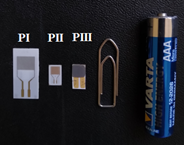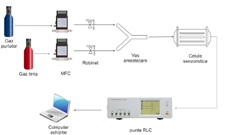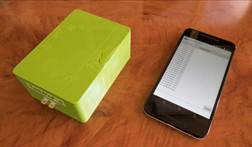|
Stage 1 (2020)
"Development of new materials for sensor applications
and design and manufacture of work masks"
In
the first stage (2020), due to the very short working time (6 months), only
two activities were foreseen, namely:
1.1.
Obtaining sol-gel solutions and depositing the film on test substrates
1.2.
Modeling, design, and manufacture of masks
In
the first activity (1.1) four types of materials for nanosensors
were made, with different morphologies, for applications in CO2,
CH4, O3 and humidity (H2O-vapors)
detection. Several chemical synthesis pathways (sol-gel method and
hydrothermal method) were used to obtain metal films with different
structures. Thus, for each of the four compounds, different ways of
synthesizing of the different compounds were used:
a)
For CO2 target gas - two different synthesis pathways were used
to obtain CuO-ZnO type heterostructures.
b)
For the target gas O3 - hierarchical structures of ZnO-SnO2
type were prepared in two stages.
c) ZnO-NiO heterojunctions were
prepared for the CH4 target gas in two stages.
d)
For water vapor (H2O-vapor) two different materials were
prepared: ZnO nanowires and ZnO-NiO
nanowires, combining the sol-gel method with the hydrothermal one.
Each
sample was thermally treated differently, each treatment being performed
according to the specifics of the sample. The intermediate and final
parameters (temperature and duration) of the heat treatment were varied to
prepare sensitive materials, with different architectures that have a high
sensitivity, fast response, and short recovery times.
In
the second activity (1.2) the structure of sensors necessary for the
preliminary tests for the detection of greenhouse gases, as well as the
ceramic substrate were designed. The designed sensor consists of two
distinct types of structures:
-
one consisting of a zone of interdigitated metal
electrodes; nanostructured thin films have been deposited on their active
zone for the detection of greenhouse gases,
- the second consists of a Pt
resistor, which has the role of heating of the ceramic substrate.
The
arrangement of the interdigitated electrode was
done with the help of a dedicated design program (CleWin)
and was followed by obtaining the two work masks.
Mask
1 - Pt heater and
Mask
2 - Ti / Au transducers.
Stage 2 (2021)
"Characterization of new materials
and development of gas sensor"
Stage
2 contained the following activities:
2.1.
Modeling and design of gas sensors
2.2.
Manufacture of gas microsensor structures
2.3.
Characterization of microstructures by XRD, AFM, SEM, SE
2.4.
Optimizing the properties of the material and depositing films on
microchips
2.5.
Dissemination and participation in technical-scientific events
The
most important results obtained in the above activities were:
Activity 2.1. Preliminary electrical measurements
performed for the detection of gases of
interest
made on the layout designed in stage 1, demonstrated the need to modify the
metal paths
in the pad area. Thus, to obtain a more
precise electrical contact between the pads of the sensitive
structure
and the pins of the electrical connector used for measurement, the layout
of the final
structure
will have the pads of the interdigitated
structure doubled in width and the distance
between the
pads will be enlarged compared to the layout of the first stage of the
project.
Activity 2.2. After the work masks were processed, we
proceeded to the manufacturing stage of the transducers we want to use for
the detection of target gases. They were made of 4” ceramic wafers. A
number of 3 ceramic wafers with a thickness of 100 µm were processed, the
total number of translators obtained being 150 chips.
Activity 2.3. In this second stage, a number of 9 new
types of films for the detection of greenhouse gases (CH4, CO2, O3, H2O-vapors) were
obtained, which were structurally (XRD) and morphologically (AFM, SEM)
characterized. These films were deposited by chemical methods (sol-gel
method, hydrothermal synthesis or liquid exfoliation), the chosen method
taking into account the configuration, respectively the dimensions of the
translators used).
Activity 2.4 Optimization of the film properties was
done by:
a)
Variation of the type of films: mixed or doped with different metals (Sn, In, Cu, Pd), choosing the
appropriate dopant for the target gas.
b)
The use of three types of translators of different sizes and thicknesses,
namely:
large
Au (IDE) / thin alumina transducer,
small
Au (IDE) / thin alumina transducer,
small Au (IDE) / thick alumina transducer.
c)
the choice of different deposit methods
d)
variation of the synthesis parameters: precursors, solution concentrations,
synthesis times, different number of deposited layers
According
to the AFM and SEM characterization techniques, the films deposited on
large transducers of type Au (IDE) / thin alumina show a higher degree of
uniformity compared to those deposited on small transducers of type Au (IDE)
/ thin alumina or alumina thick.
Doping
with different metals, combined with the deposition method, has a double
role, having an influence both on the morphology (following the
hydrothermal synthesis, rods/tubes can be obtained) and on the sample conduction.
The
materials developed and characterized in stage 2 of this project will be
tested in the stage 3, to be used as microsensors for the detection of greenhouse gases, by
connecting to an electronic module.
Activity 2.5. During this year's dissemination, a
paper was sent to an ISI journal (Nanomaterials)
and an oral communication was given at the Conference of Scientific
Research of the Romanian Academy.
Stage 3 (2022)
"Sensor testing, characterization and
technology demonstration"
The 3rd stage had the following
activities:
3.1. Testing and characterization of sensors for
each model obtained
3.2. Demonstration of the experimental model. Verification/Examination of the
reproducibility and reliability of the sensors and demonstration of the
experimental model
3.3. Dissemination and participation in
technical-scientific events
Activity 3.1. This year, in order to
optimize the experiments, the following were carried out:
-
a
new sensor-cell
-
a
new type of transducer (PIII)
-
for the ozone detection the experimental setup was modified by adding
new components, the technological level being included at TRL4.
-
a series of novel sensitive films based on CuO
and CoO with significantly improved properties
compared to the previous films obtained in the second stage were deposited
by sol-gel method, both on the PI and PIII type transducers.
The
structural characterization of the films was carried out by XRD, while the
morphological characterization was achieved by AFM and SEM and the sensing
measurements were performed separately for each gas. The greenhouse gases
were detected at working temperatures in the 25-2200C range, these low
temperatures being considered an advantage from the
economic point of view.
Activity 3.2.
The
reliability and reproducibility of each sensor for the investigated gas
were tested for 6 months. In order to assess the basis of the electrical
resistance, the sensor was maintained in the carrier gas (10 minutes),
followed by the injection (10 minutes) of the target gas with a fixed
concentration, all these steps providing the reproducibility measurements.
The sensor recovery process involves subsequently injections (for 3 times)
of the target gas, keeping the sensor in the carrier gas after each
injection (10 minutes).
The demonstration of the
experimental model was successfully carried out using the new sensor-cell.
The portable system was developed for the data acquisition from real-time measurements
with the help of a phone/ mobile application through a bluetooth
connection.
Activity
3.3.
Dissemination:
-
The paper “Investigation of the effects of rapid
thermal annealing on the electron transport mechanism in nitrogen-doped ZnO
thin films grown by RF magnetron sputtering”, authors: Simeon Simeonov, Anna Szekeres, Dencho Spassov, Mihai Anastasescu,
Ioana Stanculescu, Madalina Nicolescu, Elias Aperathitis, Mircea Modreanu,
Mariuca Gartner sent last year to Nanomaterials was published
online: 2022, 12 (1), 19; https://doi.org/10.3390/nano12010019
- The paper “Evolution of
physical properties during nanocrystalline graphene film formation”, authors: Mariuca
Gartner, Mihai Anastasescu, Hermine Stroescu, Jose Maria Calderon-Moreno,
Silviu Preda, Octavian-Gabriel Simionescu, Andrei Avram, Octavian Buiu, Coatings, is under revision.
- The paper “Influence
of Zn-doping on the properties of ITO sol-gel films deposited on different
substrates for CO2 sensing”, Madalina
Nicolescu, Maria Covei, Mihai Anastasescu, Silviu Preda, Irina Atkinson,
Hermine Stroescu, Luminita Predoana, Maria Zaharescu, Mariuca Gartner, Nanomaterials is under evaluation.
- The oral communication“MOX resistive
microsensors for low concentration methane detection”, authors: Paul
Chesler, Cristian Hornoiu, Mariuca Gartner, Marin Gheorghe will be held in November 2022, at the 9th International Electronic Conference on Sensors and
Applications, Section: Chemo-
and Biosensors (ECSA-9),
1-15.11.2022, as a result of the abstract’s acceptance.
Final
conclusions of the project
The
TRL 4 level, specified in the project proposal, was achieved by obtaining
sensitive materials deposited on micro-chips (transducers) and also by
testing them in laboratory conditions.
We
consider that this project has successfully accomplished all the proposed objectives,
leading to the obtaining and optimization of the monitoring greenhouse
gases system, related to human activities, without reducing the economic
activities. None of these results would have been possible without the funding
received from UEFISCDI.
Note
The project aimed to monitor greenhouse gases that are directly related to human activities: CO2, CH4, O3, humidity. The main result of the project was the obtaining of new technologies for manufacturing a network of miniaturized gas sensors.
For this purpose, three transducer prototypes (Fig. 1 - PI, PII and PIII) with porous alumina support and interdigitated electrodes of noble metals (Au or Pt) were manufactured, in order to achieve a good charge transfer at the gas-solid interface (targeted gas - sensitive film). Sensitive films of different chemical composition, In2O3, ZnO/NiO, CuO, CoO, were prepared by eco-friendly, cost effective chemical wet methods (hydrothermal, sol-gel) from commercially available reagents. The sensors obtained from the sensitive films deposited on the transducers were tested in the target gases using the setup schematically shown in Fig. 2. The test sensor cell, originally made of quartz, was mechanically improved, resulting a cell of aluminum, which will be patented.
A portable system was developed for real time data acquisition, with subsequent data transmission via Bluetooth connection to a mobile phone (Fig. 3). Taking into account all , a substantial contribution was achieved for informing, predicting and stimulating actions for the greenhouse gases monitoring.
 |

|
Fig. 1 Transducer prototypes (alumina substrate with Au or Pt IDE) |
Fig. 2 Schematic representation of the experimental setup used for sensoristic measurements |

|
Fig. 3 Portable system for real-time data acquisition |
Web site and all contents © Copyright YourName 2005, All rights reserved.
Free
website templates
|